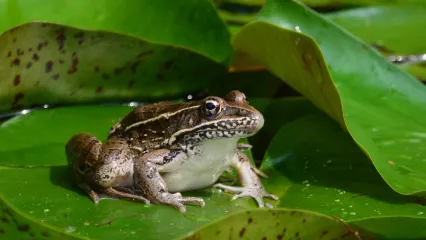
Description
Eastern narrow-mouthed toads are small, round toads with pointed heads and smooth skin, and as their name implies, small mouths. They have a distinctive fold of skin behind the eyes across the back of the head. Their coloration is variable, but individuals may have a broad stripe with irregular borders on the sides of the body. The legs are short and the small eyes are black with silver flecking. Males have a dark gray throat during the breeding season, whereas the females have a light gray throat. The only similar species is the western narrow-mouthed toad, which typically has a greenish dorsal coloration and has a light-colored belly with no markings.
Tadpoles of the eastern narrow-mouthed toad are unusual in that they do not have mouthparts with well-developed labial teeth and jaw sheaths like most other tadpoles. Instead, the tadpoles have small flaps that cover the mouth. The nearly black body is dorsolaterally flattened, and the belly is black with irregular light blotches. The tail musculature is black with a distinct lateral white stripe. The tail fins are partially clear but overlain to a variable degree with black pigmentation. The tadpoles reach about 2 inches prior to metamorphosis. Newly metamorphosed juveniles are about 0.5 inches in length.
The call of this species is a low bleating, often described as similar to that of a lamb’s bleating. An individual call lasts about 4 seconds and is frequently repeated. During especially wet periods, males begin calling in the afternoon, but most calling and breeding occurs at night.
Size
These small toads reach about 1.5 inches in length. Males are generally smaller than females.
Habitat
In the U.S., eastern narrow-mouthed toads occur from eastern Texas and Oklahoma throughout most of the southeast part of the country. Generally, they prefer forested areas.
Life Cycle
Eastern narrow-mouthed toads are primarily late spring and summer breeders. Breeding congregations form in response to rainfall in temporary ponds or weedy areas of permanent ponds, roadside ditches, flooded fields, or marshy areas. In Oklahoma, breeding typically begins in late April and extends throughout the early summer to late June or July, depending on rainfall. In dry years, relatively little breeding occurs. Males call from tufts of grass or in muddy sites at the edge of water, usually hidden from view. In large choruses early in the breeding season or after particularly heavy rains, amplexing pairs can be seen floating on the water’s surface.
Because of the smooth skin and small arms of these toads, and because females are larger than males, the male “glues” himself to the back of the female during amplexus. This is accomplished by secretion of a glue-like substance from specialized glands on the male’s chest. During mating, the female deposits about 500 eggs. The eggs are deposited singly and float on the water’s surface, but because many are deposited in the same area, they adhere loosely to each other, forming a surface film of small clusters of eggs. The eggs hatch within one or two days, and the tadpoles require from 20 to 70 days to transform to toadlets, depending on temperature.
Like most other frogs, narrow-mouthed toads feed on small insects.
How To Observe
These small frogs are not easy to observe. They are rarely found above-ground during the non-breeding season, although they are occasionally seen on roads during spring or summer rains. When the soil is damp, they can sometimes be found by turning rocks or logs. When breeding, large choruses can be heard around ponds, roadside ditches, and similar habitats. However, they frequently call from positions in deep grass or vegetation and are difficult to locate by tracing calls.
(This profile was created by Dr. Laurie Vitt as part of a partnership between the Wildlife Department and the Sam Noble Oklahoma Museum of Natural History. It was funded as part of a larger State Wildlife Grant to survey and inventory amphibians and reptiles of the Wildlife Management Areas of Oklahoma: T-35-P-1.)


